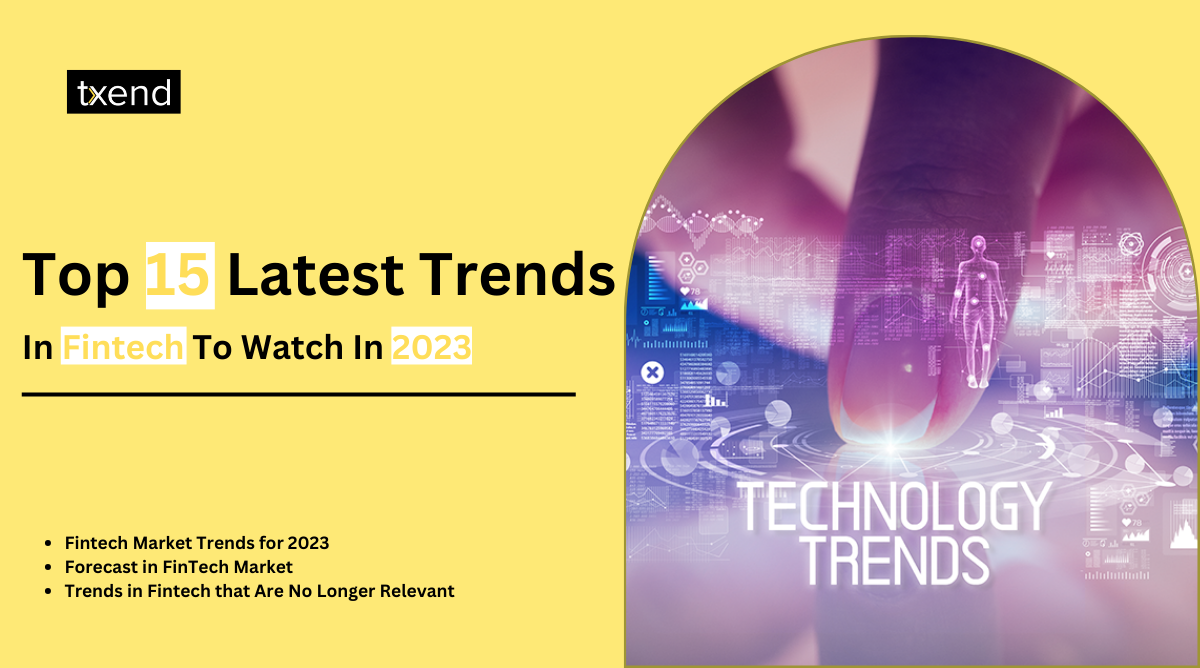Welcome to the financial frontier of 2023, where the world of finance is being reshaped by a whirlwind of innovation and technology.
In this article, we explore the dynamic landscape of “Trends in Fintech,” diving into the biggest advancements and emerging trends that are steering the financial industry into uncharted territories.

As we navigate this ever-evolving fintech landscape, join us in uncovering the top 15 latest fintech trends to watch in the year ahead.
Key takeaways
- In 2023, the USA’s trends in fintech market include virtual bank cards, embedded finance, and AI-driven financial technologies.
- The 2023 forecast for the US fintech market is one of continued growth, with heavy investments, enhanced security measures, and regulatory evolution.
- Outdated fintech trends in the USA include basic digital banking services, limited use of biometrics, traditional credit scoring, and isolated financial services.
Fintech Market Trends for 2023
Virtual Bank Cards:
Virtual bank cards are set to revolutionize digital payments, offering convenience, security, and flexibility for consumers and businesses alike. These digital cards provide seamless transactions in the online and mobile landscape.
Transforming Every Business into a Financial Hub:
Embedded finance is reshaping industries by integrating financial services directly into non-financial products and platforms. This trend empowers businesses to offer a broader range of financial solutions, from payments to lending, enhancing customer experiences.
Buy Now, Pay Later 2.0:
The Buy Now, Pay Later 2.0 trend introduces innovative features like personalized installment plans and point-of-sale financing. It redefines how consumers make purchases, providing more control and flexibility over their payments.
Alternative Lending:
Alternative lending platforms are using data-driven approaches to assess creditworthiness, making loans more accessible to individuals and small businesses. This trend challenges traditional banking models.
Real Estate Ownership Through Digital Mortgages:
Proptech leverages digital mortgages and blockchain technology to streamline real estate transactions. It simplifies property ownership, investment, and management, disrupting the real estate industry.
Alternative Payment Flows:
Alternative payment flows enable seamless and cost-effective cross-border transactions, reducing reliance on traditional banks. This trend fosters financial inclusion and global commerce.
Stablecoins:
Stablecoins offer the benefits of cryptocurrencies with price stability. These digital assets are becoming integral for fast and low-cost cross-border payments and as a store of value.
Capital Market Digitalization:
The digitalization of capital markets introduces efficiency, transparency, and accessibility, enabling a broader range of investors to participate in capital markets.

AI and ML for Financial Technologies:
Artificial intelligence and machine learning are driving data-driven decision-making, risk assessment, and automation across the financial industry, enhancing efficiency and customer experiences.
Secure and Seamless Identity Verification:
In order to increase the security of financial transactions, conventional passwords are being replaced by biometric verification techniques like fingerprint scanning and facial feature recognition.
Making Finance Engaging and Educational:
Gamification transforms financial services into engaging and educational experiences. It encourages financial literacy and motivates users to save and invest.
Distributed Ledger Technology (DLT):
DLT, including blockchain, ensures transparency and security in financial transactions. It simplifies processes like cross-border payments, settlements, and supply chain finance.
Regtech:
Regtech solutions automate regulatory compliance, reducing costs and risks for financial institutions while ensuring adherence to evolving regulatory requirements.
Open Banking APIs:
Open banking APIs enable financial institutions and fintech startups to collaborate and offer innovative financial services, benefiting consumers with more choices and better experiences.
Microservices and Modularity:
Fintech companies can respond fast to shifting market demands and client preferences thanks to microservices and modularity, which increase fintech scalability and adaptability.
These fintech trends for 2023 reflect the industry’s continued evolution towards greater innovation, accessibility, and efficiency, reshaping the financial landscape in the USA and beyond.
Forecast in FinTech Market
Continued Growth and Investment:
The US Financial technology market is anticipated to rise rapidly in 2023. Venture capital and investment inflow into fintech startups and companies are expected to remain strong, driven by the sector’s promising innovations.
Enhanced Security Measures:
With the ever-evolving threat landscape, fintech companies will continue to invest heavily in cybersecurity. Expect to see the adoption of advanced security measures, such as biometrics, to protect sensitive financial data.
Regulatory Evolution:
Regulatory technology (regtech) will play a pivotal role in ensuring fintech companies comply with increasingly complex and stringent regulations. As regulations continue to evolve, regtech solutions will adapt to streamline compliance processes.
AI and ML Integration:
Automating processes, improving customer experiences, and providing personalised financial services will all depend on the use of AI and machine learning to succeed. These technologies will empower fintech companies to offer more precise and efficient solutions.
Embedded Finance Expansion:
Embedded finance will extend beyond traditional financial services, becoming deeply integrated into various industries, such as e-commerce, healthcare, and transportation. This trend will facilitate seamless transactions and financial management within non-financial platforms.
Virtual Bank Cards and Digital Payments:
Virtual bank cards and digital payment methods will gain popularity, enabling secure, contactless transactions. Consumers will increasingly rely on these convenient options for online and offline purchases.
Rise of Buy Now, Pay Later 2.0:
Buy Now, Pay Later services will evolve to offer more flexible and personalized payment plans, providing consumers greater control and affordability.

Expansion of Alternative Lending:
By utilising data analytics to increase credit accessibility for a wider range of borrowers, including those with weak credit histories, alternative lending platforms will continue to pose a threat to established banks.
Stablecoins and Cryptocurrency Adoption:
Stablecoins will gain prominence as reliable digital assets, facilitating cross-border transactions, investments, and even salary payments. Cryptocurrency adoption will continue to grow, particularly among institutional investors.
Fintech for Real Estate:
Proptech, driven by digital mortgages and blockchain technology, will revolutionize real estate transactions. Buyers and sellers will benefit from faster, more transparent, and secure property transactions.
Gamification in Finance:
Gamification will make finance more engaging and educational. Financial institutions will incorporate gaming elements to incentivize saving, investing, and responsible financial management.
Distributed Ledger Technology (DLT) for Financial Services:
DLT, including blockchain, will be increasingly utilized for secure and transparent financial transactions, ranging from cross-border payments to supply chain finance.
Open Banking APIs and Collaboration:
Open banking APIs will foster collaboration between financial institutions and fintech startups, leading to innovative financial products and services.
Regtech Advancements:
Regtech will advance to provide even more sophisticated solutions for regulatory compliance, helping financial institutions navigate complex regulatory environments with greater ease.
Microservices and Modular Solutions:
Microservices and modular architecture will enable fintech companies to scale and customize their offerings, promoting agility and adaptability to meet evolving market demands.
The financial technology sector in the USA is anticipated to be vibrant and revolutionary in 2023, providing a variety of possibilities and inventions that will influence the direction of finance and reshape how people and organizations handle their finances.
Trends in Fintech that Are No Longer Relevant
Basic Digital Banking Services:
With the rise of embedded finance and virtual bank cards, basic digital banking services that merely replicate traditional banking without additional features are becoming less relevant. Consumers now expect more value-added services from digital banking platforms.
Limited Use of Biometrics:
As security concerns grow, relying solely on traditional username and password combinations for authentication is no longer adequate. Fintech trends now prioritize the use of biometrics, making less secure methods less relevant.
Traditional Credit Scoring Models:
The fintech industry is moving away from traditional credit scoring models that rely heavily on credit histories and scores. Innovative approaches, like alternative lending and AI-driven credit assessments, are redefining how creditworthiness is determined.
Isolated Financial Services:
Isolated financial services that do not integrate with broader ecosystems are losing relevance. Consumers seek holistic financial solutions that seamlessly connect with other aspects of their lives, like embedded finance within e-commerce platforms.
Fragmented Payment Methods:
The fintech landscape is consolidating around a few dominant digital payment methods and virtual bank cards. Fragmented and proprietary payment systems are less favored as they lack interoperability.
Limited Use of Blockchain for Cryptocurrencies:
While blockchain technology remains significant, the hype surrounding cryptocurrencies that rely solely on blockchain for transactions has waned. Stablecoins and hybrid blockchain solutions are gaining preference for practicality and stability.

Traditional Banking Structures:
The traditional banking structure, characterized by physical branches and rigid processes, is losing relevance in the face of digital banking and embedded finance. Consumers seek more flexible, efficient, and accessible financial services.
Passive Financial Apps:
Fintech apps that offer static financial information without interactivity or personalized insights are becoming obsolete. Gamification and AI-driven apps that engage users and provide tailored recommendations are in demand.
Manual Regulatory Compliance:
Manual approaches to regulatory compliance are no longer sustainable in the fast-evolving regulatory environment. Regtech solutions that automate compliance processes are essential for fintech companies to stay competitive.
Closed Financial Systems:
Fintech trends prioritize open banking APIs and collaboration with other financial institutions and startups. Closed financial systems that limit interoperability and innovation are no longer favored.
As the fintech industry in the USA continues to evolve, staying relevant means embracing emerging trends and leaving behind outdated approaches that no longer meet the demands of consumers and businesses seeking more efficient, secure, and integrated financial solutions.
How Txend Uses Financial Technology Trends in Software Development?
Txend’s approach to software development leverages the latest fintech trends to create innovative and cutting-edge solutions. Here’s how Txend incorporates financial technology trends into its software development:
Virtual Bank Cards:
Txend integrates virtual bank cards into its payment solutions, allowing users to make secure and convenient transactions online and offline. This technology enhances the user experience by providing flexible and contactless payment options.
Embedded Finance:
Txend recognizes the potential of embedded finance and offers APIs that seamlessly integrate financial services into various industries. This approach enhances business offerings by providing customers with a more comprehensive range of financial services within non-financial platforms.
Buy Now, Pay Later 2.0:
Txend’s software solutions incorporate Buy Now, Pay Later 2.0 features, enabling customers to enjoy flexible and personalized payment plans. This approach caters to evolving consumer preferences for convenient and affordable payment options.
AI and ML for Financial Technologies:
Txend harnesses artificial intelligence and machine learning to optimize financial processes and enhance decision-making. These technologies enable more accurate risk assessments, fraud detection, and personalized financial recommendations within its software applications.
Gamification:
Txend’s software development integrates gamification elements to engage users and make financial management more enjoyable and educational. Gamified features motivate users to save, invest, and achieve their financial goals.
Open Banking APIs:
Txend actively uses open banking APIs to collaborate with financial institutions and fintech partners. As a result of this, the business can provide its customers with a larger selection of financial goods and services, promoting innovation and choice.
Regtech:
Regulatory compliance is a priority for Txend. The company employs regtech solutions to automate compliance processes, ensuring its software meets evolving regulatory requirements. This approach reduces compliance risks and costs.
Distributed Ledger Technology (DLT):
Txend embraces DLT, including blockchain, for secure and transparent financial transactions within its software applications. This technology ensures data integrity and enhances trust among users.
By incorporating these fintech trends into its software development processes, Txend remains at the forefront of innovation in the fintech industry. Its commitment to leveraging these trends enhances the user experience, provides more comprehensive financial services, and ensures compliance with regulatory standards, ultimately driving its success in the competitive fintech landscape.
Frequently Asked Questions (FAQs)
The trends include virtual bank cards, embedded finance, AI integration, regtech advancements, and gamification.
Embedded finance seamlessly integrates financial services into non-financial platforms, offering convenience and a broader range of services.
Gamification makes financial management engaging and educational, motivating users to save, invest, and make informed financial decisions.
AI and ML drive data-driven insights, personalization, and automation, improving efficiency and customer experiences in financial technologies.
By making it possible to develop cutting-edge financial goods and services, open banking APIs encourage cooperation and innovation.
Conclusion
In conclusion, the dynamic world of finance and technology is constantly evolving, and the fintech landscape in 2023 is nothing short of transformative. As we’ve explored the top 15 latest trends in fintech to watch, it’s evident that the industry is poised for a future marked by innovation, convenience, and accessibility. From virtual bank cards to embedded finance, AI-driven solutions and regtech advancements, these trends are reshaping the way we interact with money and financial services.
Both organisations and consumers must stay informed and adapt to these developments as we traverse this fintech world. Embracing these fintech developments can enable you to make wiser financial decisions and improve your overall financial well-being, whether you’re a consumer who loves technology, an entrepreneur, or a financial enthusiast.
In the USA and beyond, fintech is not just about technology; it’s about improving financial experiences, increasing financial inclusion, and driving economic growth. As we look ahead to 2023 and beyond, these trends will continue to redefine finance and pave the way for a more interconnected, efficient, and innovative financial future. So, keep a close eye on these trends and be ready to ride the wave of fintech innovation in the years to come.



